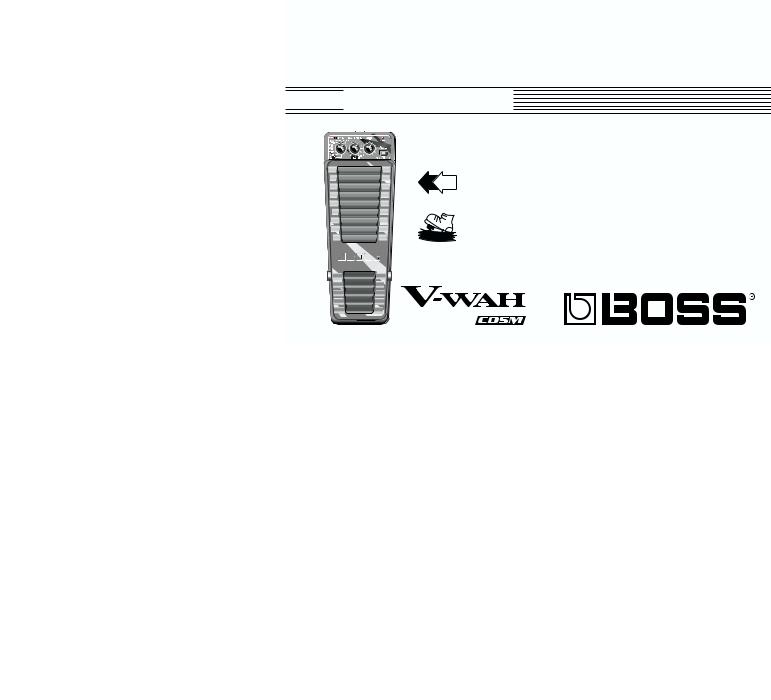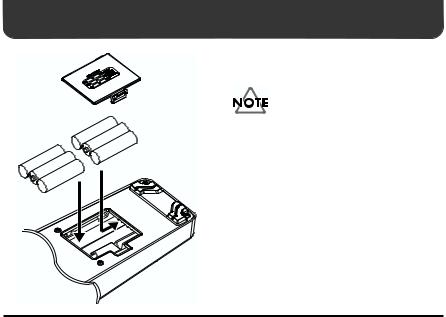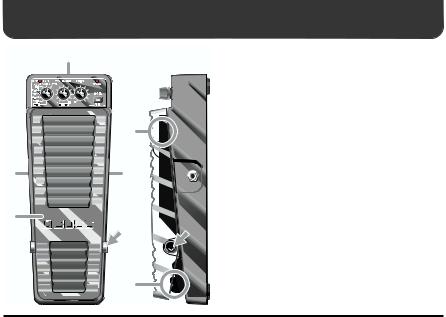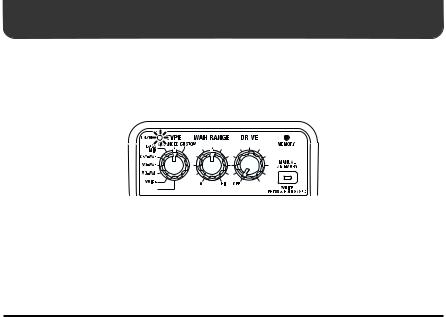Roland PW 10 Service Manual

PW-10 WAH PEDAL
 Owner’s Manual
Owner’s Manual
AC DC
AC & BATTERY
POWERED
FET
Thank you, and congratulations on your choice of BOSS PW-10 Wah Pedal.
Before using this unit, carefully read the sections entitled: “USING THE UNIT SAFELY” and “IMPORTANT NOTES” (separate sheet). These sections provide important information concerning the proper operation of the unit. Additionally, in order to feel assured that you have gained a good grasp of every feature provided by your new unit, this manual should be read in its entirety. The manual should be saved and kept on hand as a convenient reference.

Main Features
●The world’s first modeling wah pedal, utilizing COSM technology to create a wide variety of wah sounds
Eight different sounds include an original BOSS “ADVANCED” tone and the sound of “vintage wah” pedals that are now so hard to obtain, “DOUBLE RESONANCE,” which creates an analog synth-like sound, “UNI-V,” with a filter effect for that 70’s sound, and even a new “VOICE” effect that produces “talking” modulation sounds and realistic human voice sounds. Also included is a CUSTOMIZE function that lets you create your own original wah sounds.
●The infrared sensor “contactless pedal position detection” system both eliminates forever the scratchy noise that has previously been a problem when changing the volume, while also providing a previously unavailable smooth pedal action.
●Features a “WAH RANGE” function that allows you to freely adjust the wah effect range.
●Also has a DRIVE function that actively supports distortion, an effect that complements the wah pedal. Allows you to use eight different “distortion” effects such as “METAL ZONE,” “FUZZ,” and BOOSTER.”
●The MEMORY function lets you take the changes you have made to the effect type, DRIVE, and other settings, and store them as custom wah effects. You can store up to three of such custom settings. You can also use the pedal to call up UNI-V and DRIVE distortion instantly.
●A high-performance “noise suppressor” eliminates the wah pedal’s characteristic filter noise.
2

Contents |
|
Main Features..................................................................................................... |
2 |
Installing Batteries ............................................................................................. |
4 |
Part Names and Functions ............................................................................... |
6 |
Making the Connections................................................................................... |
10 |
Operation ............................................................................................................ |
13 |
Storing Settings (Write Operation) ................................................................. |
18 |
Changing the Operation of the Heel Switch.................................................. |
20 |
Creating “Custom” Wah Effects (Customize Mode).................................... |
22 |
Setting the DRIVE/Noise Suppressor (DRIVE SELECT Mode)................. |
26 |
Returning Settings to Their Factory Defaults (Factory Reset) .................... |
29 |
Resetting the Pedal Sensitivity (PEDAL CALIBRATION Mode)............... |
31 |
Setting Mode chart ............................................................................................ |
34 |
Troubleshooting................................................................................................. |
35 |
Sample Settings.................................................................................................. |
37 |
Specifications...................................................................................................... |
40 |
Copyright © 2001 BOSS CORPORATION |
|
All rights reserved. No part of this publication may be reproduced in any form without |
|
the written permission of BOSS CORPORATION. |
|
3

Installing Batteries
Insert the included batteries as shown in figure, being careful to orient the batteries correctly.
• Batteries are supplied with the unit. The life of these batteries may be limited, however, since their primary purpose was to enable testing.
• When turning the unit upside-down, get a bunch of newspapers or magazines, and place them under the four corners or at both ends to prevent damage to controls. Also, you should try to orient the unit so no controls get damaged.
• Make sure the “+” and “-” ends of the batteries are oriented correctly.
• Do not mix fresh batteries with used ones, or mix batteries of different types. Doing so can result in fluid leakage.
4

Installing Batteries
*When turning the unit upside-down, handle with care to avoid dropping it, or allowing it to fall or tip over.
*When the batteries run down, the ON/OFF indicator gets dim. If this happens, replace with new batteries.
*When replacing the batteries, use six R6/LR6 (AA) type.
*Battery life can vary depending on battery type.
*Firmly close the battery cover—you should hear it click into place.
Continuous usage time under battery power is about 38 hours with alkaline batteries and about 14 hours with carbon batteries. (This may vary according to usage conditions.)
5

Part Names and Functions
1
5
3 |
2 |
4
6
1. AC Adaptor Jack
This jack is for connecting an AC adaptor (BOSS PSA-series, sold separately). Using an AC adaptor makes possible long performances with no worry about batteries going dead.
2. INPUT Jack
This jack is for connection to an electric guitar or bass guitar.
*The INPUT jack also doubles as the power switch when the unit is running on battery power. The power comes on when a plug is inserted into the INPUT jack, and goes off when it is unplugged. Unplug any connected cords when the unit is not in use.
3. OUTPUT Jack
This jack is for connection to a guitar amp or another effects processor.
6

Part Names and Functions
4. Pedal
Controls the wah effect.
Step down hard on the pedal, and the toe switch is activated. Rock the pedal back, then put firm pressure on the heel to activate the heel switch.
You can change the pedal torque (the force or load required to pivot the pedal) by adjusting the screw located on the right side of the unit (shown by arrow).
*Use a hexagon socket screw key (5 mm) to adjust the screw.
*Take care not to overtighten the screw; doing so may damage the unit.
When you operate the pedal, please be careful not to get your fingers pinched between the movable part and the panel. In households with small children, an adult should provide supervision until the child is capable of following all the rules essential for the safe operation of the unit.
5. Toe Switch
Switches on/off the effect selected with the TYPE knob.
* The distortion remains turned on.
6. Heel Switch
This switches between “MANUAL” and “MEMORY (1–3).”
When the heel switch is pressed continuously for two or more seconds, the ON/OFF indicator flashes, and the pedal switches to bypass mode (operating the pedal or adjusting the knobs switches the pedal out of bypass).
When bypass is in effect, guitar sounds input at the INPUT jack are output from the OUTPUT jack without being altered.
*You can change the way the heel switch changes between “MANUAL” and “MEMORY (1–3).” For more on how to change this setting, refer to “Changing the Operation of the heel switch” (p. 20).
7

Part Names and Functions
7 |
|
|
8 |
9 |
10 |
11 |
12 |
7. ON/OFF Indicator
This lights up when the wah effect selected with the TYPE knob is on. The indicator blinks when the unit is in bypass.
*When the batteries run down, the ON/ OFF indicator gets dim. If this happens, replace with new batteries.
*The ON/OFF indicator shows whether the wah effect is being applied or not. It does not indicate whether the power to the device is on or not.
8. MEMORY Indicator
This lights up when set to “MEMORY (1–3).” The color of the light changes according to which Memory is selected.
• Memory 1 |
red |
• Memory 2 |
green |
• Memory 3 |
yellow |
8

Part Names and Functions
9. TYPE Knob
This selects the effect to be controlled with the pedal. (p. 14)
10. WAH RANGE Knob
This adjusts the range of frequencies to which the wah effect is applied.
*When TYPE is set to “VOICE,” this knob selects the type of expression used.
When set to “UNI-V,” this functions as an INTENSITY knob, which adjusts the depth of the undulation. (p. 15–16)
11. DRIVE Knob
This adjusts the amount of distortion.
*Although the output level of DRIVE is already set to the appropriate level, it can also be changed in DRIVE SELECT mode (p. 26), and when carrying out the write operation (p. 18).
12. MANUAL/MEMORY Button
Pressed to select from “MANUAL” and “MEMORY (1–3).”
•MANUAL:
The output sound directly reflects the settings of the panel controls.
•MEMORY:
The MEMORY indicator lights up, and sounds are output according to the settings saved to Memories 1–3.
*Holding this down for two seconds or longer switches the unit to the write operation.
9

Making the Connections
|
|
|
|
|
|
|
|
|
|
|
|
|
|
|
|
|
|
|
|
|
|
|
|
|
AC Adaptor |
|
|
|
|
|
|
|
|
|
|
|
|
PSA-series |
Effector |
|
|
|
(option) |
||||||||
|
||||||||||||
|
|
|
|
|||||||||
|
|
|
|
|
|
|
|
|
|
|
|
|
|
|
|
|
|
|
|
|
|
|
|
|
|
|
|
|
|
|
|
|
|
|
|
|
|
|
|
|
|
|
|
|
|
|
|
|
|
|
|
|
|
|
|
|
|
|
|
|
|
|
|
|
|
|
|
|
|
|
|
|
|
|
|
|
|
|
|
|
|
|
|
|
|
|
|
|
|
|
|
|
|
|
|
|
|
|
|
|
|
|
|
|
|
|
|
|
|
|
|
|
|
|
|
|
|
|
|
|
|
|
|
|
|
|
|
|
|
|
|
|
|
|
|
|
|
|
|
|
|
|
|
|
|
|
|
|
|
|
|
|
|
|
|
|
|
|
|
|
|
|
|
|
|
|
|
|
Electric |
or |
Bass |
|
Guitar |
Guitar |
||
|
or
Guitar Amplifier |
Bass Amplifier |
10

Making the Connections
•Noise may be produced if wireless communications devices, such as cell phones, are operated in the vicinity of this unit. Such noise could occur when receiving or initiating a call, or while conversing. Should you experience such problems, you should relocate such wireless devices so they are at a greater distance from this unit, or switch them off.
•Use a cable from Roland to make the connection. If using some other make of connection cable, please note the following precautions.
•Some connection cables contain resistors. Do not use cables that incorporate resistors for connecting to this unit. The use of such cables can cause the sound level to be extremely low, or impossible to hear. For information on cable specifications, contact the manufacturer of the cable.
•To prevent malfunction and/or damage to speakers or other devices, always turn down the volume, and turn off the power on all devices before making any connections.
•If there are batteries in the unit while an AC adaptor is being used, normal operation will continue should the line voltage be interrupted (power blackout or power cord disconnection).
11

Making the Connections
Turninng the Power On
Once the connections have been completed, turn on power to your various devices in the order specified. By turning on devices in the wrong order, you risk causing malfunction and/or damage to speakers and other devices.
• When powering up: |
Turn on the power to your guitar amp last. |
• When powering down: |
Turn off the power to your guitar amp first. |
*When the unit is running on battery power, the power comes on when you insert the connector plug into the INPUT jack.
*You may hear some sound when the power is switched on, but this is normal, and does not indicate a malfunction.
*When operating on battery power only, the ON/OFF indicator will become dim when battery power gets too low. Replace the battery as soon as possible.
12

Operation
So you are better able to follow along with the following explanations, you should first step down firmly on the pedal to switch on the toe switch, and turn on the wah effect (ON/OFF indicator is lit).
Also, set the WAH RANGE knob to the center position, and the DRIVE knob to OFF, and press the MANUAL/MEMORY button to set it to “MEMORY” (MEMORY indicator lighted).
|
|
|
|
|
|
|
|
|
|
|
|
|
|
|
|
|
|
|
|
|
|
|
|
|
|
|
|
|
|
|
|
|
|
|
|
|
|
|
|
|
|
|
|
|
|
|
|
|
|
|
|
|
|
|
|
|
|
|
|
|
|
|
|
|
|
|
|
|
|
|
|
|
|
|
|
|
|
|
|
|
|
|
|
|
|
|
|
1 |
2 |
3 |
4 |
|||||||
13

Operation
1. Select the desired effect with the TYPE knob.
TYPE |
Description |
CUSTOM |
Your own original wah effect, created using the Customize function (p. |
|
22). |
|
|
ADVANCED |
New BOSS original wah effect that provides a wider range of tone changes. |
|
|
BASS MIX |
New type of wah effect suitable for bass, with no attenuation of the lower |
|
range. |
|
|
CBY-WAH |
Models the sound of the JMI Cry Baby. |
|
|
VO-WAH |
Models the sound of the VOX V846. |
|
|
MO-WAH |
Models the sound of the Morley Bad Horsie. |
|
|
VOICE |
A further advancement beyond the BOSS HUMANIZER, this effect pro- |
|
duces “talking” modulation sounds and realistic human voice sounds. |
|
|
UNI-V |
Models the sound of the “Uni-Vibe” effect reminiscent of the late 60’s and |
|
70’s. |
*All product names mentioned in this document are trademarks or registered trademarks of their respective owners. Those companies are not affiliated with BOSS and have not licenced or authorized BOSS's PW-10. Their marks are used solely to identify the equipment whose sound is simulated by BOSS's PW-10.
14
